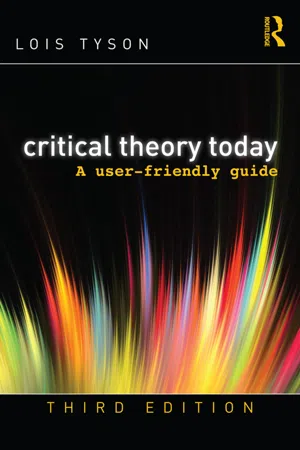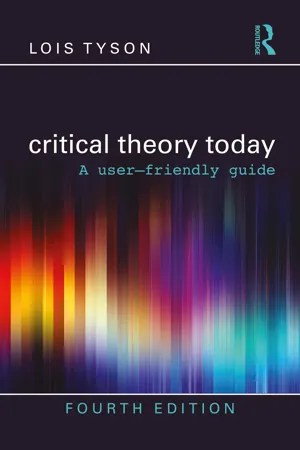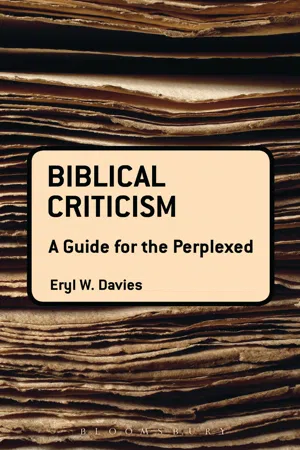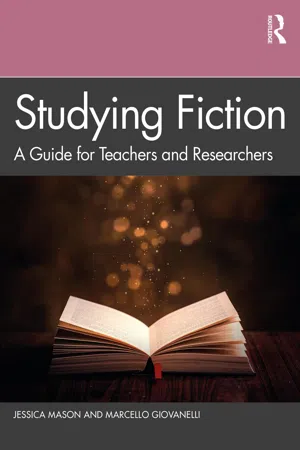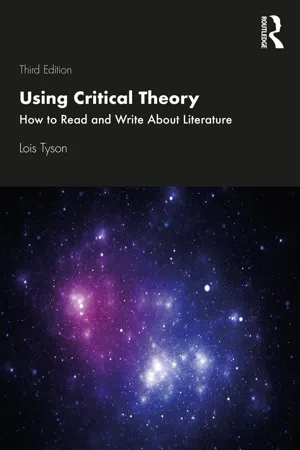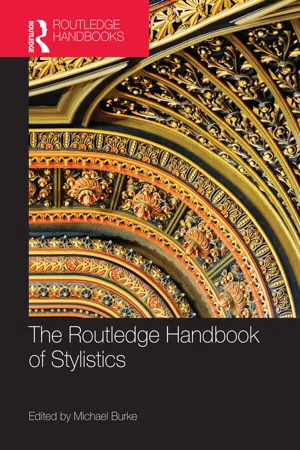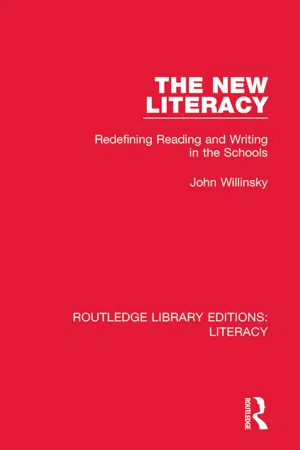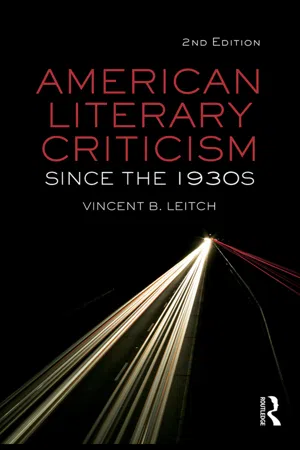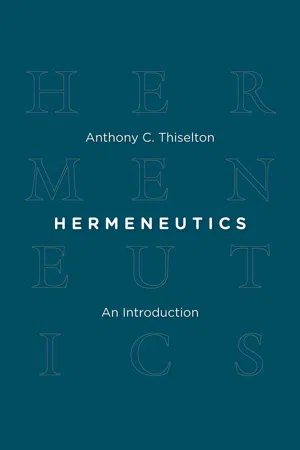Literature
Reader Response Criticism
Reader Response Criticism focuses on the reader's personal and emotional response to a literary work, emphasizing the role of the reader in interpreting and understanding the text. This approach suggests that meaning is not solely determined by the author's intentions, but is also shaped by the reader's experiences, beliefs, and cultural background, leading to diverse and subjective interpretations of the same text.
Written by Perlego with AI-assistance
Related key terms
Related key terms
1 of 4
Related key terms
1 of 3
11 Key excerpts on "Reader Response Criticism"
- eBook - ePub
Critical Theory Today
A User-Friendly Guide
- Lois Tyson(Author)
- 2014(Publication Date)
- Routledge(Publisher)
6 Reader-response criticismAs its name implies, reader-response criticism focuses on readers’ responses to literary texts. Many new students of critical theory are relieved and happy when they get to the unit on reader-response criticism, perhaps because they enjoy the idea that their responses are important enough to become the focus of literary interpretation. Or perhaps they assume that reader-response criticism means “I can’t be wrong because any way I interpret the text is my response, so the professor can’t reject it.” Let me break the bad news to you up front. Depending on the kind of reader-response theory we’re talking about, your response to a literary text can be judged insufficient or less sufficient than others. And even when a given reader-response theory does assert that there is no such thing as an insufficient (or inaccurate or inappropriate) response, your job as a practitioner of that theory isn’t merely to respond but to analyze your response, or the responses of others, and that analysis can be found wanting.The good news, however, is that reader-response criticism is a broad, exciting, evolving domain of literary studies that can help us learn about our own reading processes and how they relate to, among other things, specific elements in the texts we read, our life experiences, and the intellectual community of which we are members. In addition, for those of you who plan on teaching or are already doing so, reader-response theory offers ideas that can help you in the classroom, whether that classroom is in an elementary school or on a college campus.If you’re getting the feeling that reader-response criticism covers a good deal of diverse ground, you’re right. In fact, any time an essay analyzes the act of reading or readers’ responses, one could classify that essay as reader-response criticism. For example, psychoanalytic criticism, when it investigates the psychological motives for certain kinds of interpretations of a literary text, is also a form of reader-response criticism. Feminist criticism, when it analyzes how patriarchy teaches us to interpret texts in a sexist manner, is also a form of reader-response criticism. Structuralist criticism, when it examines the literary conventions a reader must have consciously or unconsciously internalized in order to be able to read a particular literary text, is also considered a form of reader-response criticism.1 - eBook - ePub
Critical Theory Today
A User-Friendly Guide
- Lois Tyson(Author)
- 2023(Publication Date)
- Routledge(Publisher)
6 Reader-response criticism
DOI: 10.4324/9781003148616-6As its name implies, reader-response criticism focuses on readers’ responses to literary texts. Many new students of critical theory are relieved and happy when they get to the unit on reader-response criticism, perhaps because they enjoy the idea that their responses are important enough to become the focus of literary interpretation. Or perhaps they assume that reader-response criticism means “I can’t be wrong because any way I interpret the text is my response, so the professor can’t reject it.” Let me break the bad news to you up front. Depending on the kind of reader-response theory we’re talking about, your response to a literary text can be judged insufficient or less sufficient than others. And even when a given reader-response theory does assert that there is no such thing as an insufficient (or inaccurate or inappropriate) response, your job as a practitioner of that theory isn’t merely to respond but to analyze your response, or the responses of others, and that analysis can be found wanting.The good news, however, is that reader-response criticism is a broad, exciting, evolving domain of literary studies that can help us learn about our own reading processes and how they relate to, among other things, specific elements in the texts we read, our life experiences, and the intellectual community of which we are members. In addition, for those of you who plan on teaching or are already doing so, reader-response theory offers ideas that can help you in the classroom, whether that classroom is in an elementary school or on a college campus.If you’re getting the feeling that reader-response criticism covers a good deal of diverse ground, you’re right. In fact, any time an essay analyzes the act of reading or readers’ responses, one could classify that essay as reader-response criticism. For example, psychoanalytic criticism, when it investigates the psychological motives for certain kinds of interpretations of a literary text, is also a form of reader-response criticism. Feminist criticism, when it analyzes how patriarchy teaches us to interpret texts in a sexist manner, is also a form of reader-response criticism. Structuralist criticism, when it examines the literary conventions a reader must have consciously or unconsciously internalized in order to be able to read a particular literary text, is also considered a form of reader-response criticism.1 - eBook - ePub
- Eryl W. Davies(Author)
- 2013(Publication Date)
- T&T Clark(Publisher)
The text-centred approach of the New Critics, however, gradually came to be viewed as grossly inadequate, for there was an increasing awareness that literary compositions could not be hermetically sealed from history and isolated from the cultural context in which they were written. Nor, indeed, could they be studied in isolation from their readers. The role of the reader could not simply be marginalized or ignored, for readers were active participants in the determination of literary meaning and creative contributors to the interpretative process. Literary compositions should not be prised away from their contexts of meaning and response, for texts meant what they meant to particular people at particular times and in particular circumstances. The subject (reader) and the object (text) were indivisibly bound together, and the relationship between them was a dynamic process, for texts only became alive and meaningful when people became involved with them and responded to them.This new approach, known as ‘reader-response criticism’, clearly represented a radical departure from the type of methodology advocated by the New Critics.1 While the latter had exalted the text over both author and reader, the reader-response critics sought to challenge the privileged status of the text and emphasize instead the role of the reader and the profound significance of the reading experience. While the New Critics had dismissed the reader’s response as subjective and hopelessly relativistic, the reader-response critics argued that the interplay between text and reader was of considerable significance for the interpretation of a literary work.This interplay was particularly emphasized by Wolfgang Iser, who was one of the leading advocates of the reader-response approach (1974; 1978). As the quotation at the beginning of this chapter indicates, Iser argued that the reader must take into account not only the text itself but also the actions involved in responding to that text. Such actions were determined, in large measure, by the literary text itself, for the text was usually full of gaps and indeterminacies, and it was precisely these gaps that activated readers’ faculties and stimulated their creative participation. The reader was invited to engage with the text by filling in the blanks and inferring that which the text had withheld. Reading was a process of anticipation and retrospection which involved the deciphering of words and sentences, the relating of parts to the whole, the modifying of perspectives, the revising of assumptions, the readjustment of perceptions, the asking of questions and the supplying of answers. Instead of looking behind the text for the meaning, the meaning was to be found in front of - eBook - ePub
Studying Fiction
A Guide for Teachers and Researchers
- Jessica Mason, Marcello Giovanelli(Authors)
- 2021(Publication Date)
- Routledge(Publisher)
respond to that text. As in Example 1, readers may interpret the same words in very different ways justifying their reading in terms of preference and emotional response. And, as in Example 2, readers may impose specific ways of reading onto a text, in this instance framed within certain institutional parameters and expectations. Fish uses the term ‘interpretive communities’ (1980: 14) to show how readers’ own responses arise through membership of larger social groups with conventional ways of looking at texts and with categories (e.g. ‘literature’, ‘poetry’) through which readings are then framed. In both cases, readers are responsible for generating meaning; meaning is not simply there to be found.6.2 Reader-response theories and education
There are various theories of reading that highlight the importance of the reader. These theories are fairly recent and stand in contrast to two other ways of thinking about meaning in a text.In the first, literary critics in the nineteenth and early twentieth century focused on the author as the source of a text’s meaning and attached importance to extra-textual (biography, history) detail. In the second, critics working around the mid twentieth century shifted the focus on to the text as a self-contained entity, most notably in a practice that came to be known as New Criticism (e.g. Brooks 1947; Welleck and Warren 1949). New Critics generally viewed both knowledge about the author and the reader’s emotional response as irrelevant to the study of literature (although New Critics tended to focus largely on poetry). Reading – or deciphering – a poem was largely about working out a meaning that resided in its internal structure and could be deduced from a close and careful analysis of its oppositions and tensions; the poem in effect was an autonomous entity.Over the last 50 years or so, advances in literary and cultural theory, in linguistics, and in psychology and cognitive science have led to ideas that aim to account more explicitly for the role of the reader without necessarily dismissing the author and the text. Beach (1993) draws attention to five separate theorisations of reader-response that have been particularly influential in educational contexts. Although written some time ago, Beach’s list still provides a useful overview of the range of reader-response theories that exist. We list these below with some added discussion of each. - eBook - ePub
Using Critical Theory
How to Read and Write About Literature
- Lois Tyson(Author)
- 2020(Publication Date)
- Routledge(Publisher)
Chapter 2Using concepts from reader-response theory to understand our own literary interpretations
Why should we learn about reader-response theory?
Most of us are intrigued, I think, by the prospect of learning something interesting or useful about ourselves. That’s precisely what reader-response theory offers us, and perhaps that’s why it has become a popular framework for the study of literature.There are, however, several different kinds of reader-response theory, and they aren’t all interested in the same kinds of self-knowledge. Some reader-response approaches examine the ways in which our literary interpretations are influenced by social factors: for example, by the social or cultural group with which we identify, by the system of education that tells us what literary works are important and how they should be interpreted, or even by the classmates whose opinions influence our responses as we read literary works together. Other reader-response approaches analyze literary works themselves in order to determine how our responses are guided by the way a work is written: for instance, the amount of information provided about characters and plot, the order in which that information is provided, and the attitude of the narrator that provides it. Finally, some reader-response approaches try to determine how our responses to literary works are influenced by our personal experiences, by the emotional or psychological dimension of our daily lives: for example, our likes and dislikes, our loves, our fears, our desires, and our memories.It is this last kind of reader-response theory that we are interested in here. For despite their differences, all reader-response theories have one important thing in common. They all believe that readers play an active role in making - eBook - ePub
- Michael Burke(Author)
- 2017(Publication Date)
- Routledge(Publisher)
4 Reader Response Criticism and stylistics
Jennifer Riddle Harding DOI: 10.4324/9781315795331-5Introduction
A famous philosophical question goes something like this: when a tree falls in the woods, if there’s nobody there to hear it, does it make a sound? To understand the emphasis of reader response theory, one might analogously ask: does a text have any meaning if there’s no reader there to interpret it? This was the basic issue that originally motivated reader response theory in the 1970s, when theorists reacted to an earlier dominant paradigm that regarded texts as self-contained icons, and readers’ interpretations as irrelevant in critical analyses. In order to understand what inspired the turn to Reader Response Criticism, let’s first consider the paradigm that was dominant prior to the 1970s.These earlier literary critics, referred to as formalists or practitioners of New Criticism, maintained that critical focus should be on texts. In his formalist classic The Well Wrought Urn, for example, Cleanth Brooks warned that critics should be wary of ‘yielding to the temptation to take certain remarks which we make about the poem – statements about what it says or about what truth it gives or about what formulations it illustrates – for the essential core of the poem itself’ (1947, p. 1221). In this view, the work of literature (formalists tended to call all works ‘poems’) was exalted while its interpretation was not. The emphasis was on the ‘essential core’ of the work, not on the readers’ generative process of reading, understanding, and appreciating it.Formalist critics warned particularly about the misleading interpretations that could result from investing too much authority in readers’ emotional responses. William Wimsatt Jr. and Monroe Beardsley labelled this emphasis on emotion the ‘Affective Fallacy’, which they described in their book The Verbal Icon. Wimsatt and Beardsley argued that it would be fallacious to consider the emotional impact of a text on a reader; a reader’s affective response should be considered, in this view, inconsequential to the critical study of the text. As the authors contended, ‘The Affective Fallacy is a confusion between the poem and its results (what it is and what it does - Bethan Marshall, Jackie Manuel, Donna L. Pasternak, Jennifer Rowsell, Bethan Marshall, Jackie Manuel, Donna L. Pasternak, Jennifer Rowsell(Authors)
- 2020(Publication Date)
- Bloomsbury Academic(Publisher)
2 Reader response in the classroomJohn YandellInstitute of Education, UCL, London, UKIt is now over half a century since Roland Barthes (1968/1977) announced the death of the author and, as its necessary and desirable concomitant, the birth of the reader. And it is possible to see all the significant developments in literary theory over the past fifty years – feminist and postcolonialist as well as reader response itself – as reflecting and enacting this shift in attention away from the author and the circumstances of the production towards the readers and the conditions of reception of the text. Thus Terry Eagleton (1996) proposed that the history of modern literary theory could be divided into three periods, each with a different focus: from the author (in the nineteenth century) to the text (New Criticism in 1940s and 1950s) to the reader (from the 1960s onwards). Though this might be a useful representation of dominant currents in literary theory, it is perhaps less pertinent to the ways in which literary study is experienced within the school system – or to the ways in which the literary figures in wider society.One of the problems with the term ‘reader response’ is that it is so broad a category as to encompass almost all the developments in literary theory since the 1960s. Any approach that treats the text not so much as a stable repository of meaning and more as a set of meaning-potentials, as one necessary constituent part of the reading process, can be labelled as reader response. Within this capacious category, there are very different approaches to reading in general and literary practice in particular. Even the breach with New Criticism and its insistence on an unwavering focus on the text itself (Wimsatt 1954/1970) are not always as absolute as might be assumed. The emphasis in affective stylistics (Fish 1970), for example, or in Rosenblatt’s (1938/1995, 1978) notion of the reading process as a transaction between text and reader, promotes forms of close reading that are not always easily distinguishable from New Critical perspectives. Here, the emphasis is on the process of reading, the complex ways in which meaning develops over time.- eBook - ePub
The New Literacy
Redefining Reading and Writing in the Schools
- John Willinsky(Author)
- 2017(Publication Date)
- Routledge(Publisher)
2 Reader-response is a theory of literary criticism which focuses on the way in which texts work on readers (Tompkins, 1980). It dares to fly in the face of what New Critics, Wimsatt and Beardsley (1954) identified as “the affective fallacy” which warned readers not to be mislead by how they were affected or moved by a work in the careful and systematic labors of an unaffected, close reading. As many readers will recognize from their own school experiences, the close readings of New Criticism dominated the teaching of English in the colleges and schools since the 1950s, and in many instances continues to do so. Reader-response is its undoing. Rather than hold that there is “a confusion between the poem and its results” or deny “the psychological effects of a poem,” as New Critics did in their efforts to create a science of their trade (Wimsatt & Beardsley, 1954, p. 21), reader-response criticism speaks to the literary experience, to the pleasurable and stirring times spent with books, rather than an analysis of the artifact. Terry Eagleton has suggested that after the Romantic and nineteenth century interest in the author and the New Critics attention to the text, the reader’s turn has indeed arrived (1983, p. 74).Not surprisingly, I feel that reader-response theory has more to offer the New Literacy than timeliness. As I have intimated, it is this experience with books that brings teachers to language arts classes in the first place and it is what they affect in the class in the hope of offering as much to students. We may wonder if this is too much to hope for: is the classroom the right place for literary experience? We might compare Robert Frost’s confidence that the “earth’s the right place for love: / I don’t know where it is likely to go better.” If I’m not as certain about literature in the classroom, I at least hold that reader-response theory offers to make literature go better for students. If the classroom can be transformed into something close to a community of readers finding their own way into literature, then the classroom seems a likely spot to work with a text about which so much can be said of the great deal that has gone into it. The classroom may also be a better spot with the New Literacy because there students are reading as writers, as those who are working the same ground in different ways. Writing is a common medium for author and student under the New Literacy, which gives reading a different significance than watching a video. - eBook - ePub
- Vincent B. Leitch(Author)
- 2009(Publication Date)
- Routledge(Publisher)
While most of the leading critics associated with the reader-response movement sought to change traditional pedagogical practice and theory, they did not attempt to alter the canon of established great literary works. Consequently, they limited the scope of their enterprise. What was, in part, at issue here was the applicability of the techniques of personalized reading promoted by receptionists. Because reader-response methods applied to any literature from any period and genre, there was no drive to invent or privilege a special canon the way the New Critics did. However, Reader-Response Critics, particularly of the phenomenological and hermeneutical variety, slowed the pace of “normal” reading (as did certain Deconstructive Critics). This change entailed an attack on theories of spatial form in favor of new concepts of serial, sequential, and temporal “form.” Unlike the New Critics, who preferred short, poetic kinds of literature, Reader-Response Critics were as comfortable with long as with short kinds and as content with prose as with poetry. Consequently, long-standing limits on the canon were loosened somewhat. Holland allowed film to slip in, for instance. Although a more generous and inclusive view of the canon evolved, a countervailing need to assess and judge works aesthetically did not emerge. Like historical criticism, judicial criticism remained out of favor. In the absence of these two discredited practices, reformation of the canon was unlikely to occur in reader-response criticism. Not surprisingly, university feminists, Black Aestheticians, and other ethnic critics of the time had reason to complain about the unchanged status of the canon in the hands of leading Reader-Response Critics. Even in later years, when they turned toward sociological theory, Reader-Response Critics focused primarily on small communities of students and professors, interacting with canonical literature, avoiding analysis of social discourse and popular culture. Starting in the late 1970s, feminist receptionists worked to change this narrow focus and to expand the canon—a project in line with a broad turn to historical, political, and ideological analysis across literary criticism and theory.To arrive at a fuller understanding of the various branches of American reader-response criticism, we shall consider the contributions of Structuralist Critics to theories of reading and the reader. In the fourth section of the next chapter, we examine the accounts of textual reception proffered by Michael Riffaterre, Gerald Prince, Jonathan Culler, and Robert Scholes. In the penultimate section of Chapter 14 , we return to Radway’s Reading the Romance - eBook - ePub
- Andrew Bennett(Author)
- 2014(Publication Date)
- Routledge(Publisher)
They made public their own private responses as well as the responses of their students. As Susan Suleiman noted, such ‘criticism takes us as far as we can go in the investigation of reading as private experience – an experience in which the determining factor is the individual “life history”, not the history of groups and nations’ (pp. 31–2). Privileging the idiosyncratic over the norm and the singular over the collective, Bleich's subjective criticism left the text completely behind as a regulator of response. In this he differed from Holland, whose transactive criticism credited textual constraints. 18 Both critics, however, promoted efforts to renew literary pedagogy and to value individual student readers. Such a project prompted even sympathetic critics to doubts, as was clear in Steven Mailloux's Interpretive Conventions (1982) and William Ray's Literary Meaning (1984), both of which stressed the absence of adequate sociological and institutional analyses inherent in contemporary reader-response psychological criticism. Reading as resistance: feminism and Marxism During the heyday of the reader-response movement, none of the leaders explicitly addressed the matter of gender – an issue that Feminist Critics began to raise in the 1970s. Do women read differently from men? Does sexual identity influence understanding? What role does gender play in literature? In criticism? Here Fish, Holland, and Bleich had nothing to say. Neither Suleiman and Crosman nor Tompkins considered such questions in their antnologies. In fact, the issue of gender remained unexplored by leading Phenomenological, Existential, Hermeneutical, Structuralist, and Deconstructive Critics during the early Space Age - eBook - ePub
Hermeneutics
An Introduction
- Anthony C. Thiselton(Author)
- 2009(Publication Date)
- Eerdmans(Publisher)
Chapter XV Reader-Response and Reception Theory 1. Reader-Response Theory: Its Origins and DiversityReader-response theory places an emphasis on the active role of the reader in interpreting texts. At its simplest, it depends on the axiom that a reader, or community of readers, “completes” the meaning of a text. It rests on the assumption that even if it may speak legitimately of an author’s intention, that intention is not fulfilled until a reader (or readers) appropriates the text. The text, as the “sender” of a message or other content, remains a potential until the reader actualizes it. The text remains an abstraction until it is interpreted and understood by its reader. The theory also stresses that the reader is not a passive spectator but actively contributes something to the meaning. He or she is more than a passive observer.A parable provides a classic example of a text that a reader’s response “completes.” Many years ago Charles H. Dodd defined a parable proper as “leaving the mind in sufficient doubt about its precise application to tease it into active thought.”1 But many parables are extreme examples of what Umberto Eco would call “open” texts. In a “closed” text, or “engineering” text, or in a medical prescription, the freedom of the “receiver,” or the engineer or pharmacist, is severely restricted, in case the intention or instructions of the author become varied or distorted. Hence “reader-response theory” may apply especially or even only to “literary” texts, or to “open” texts within the Bible. Controversy often arises because of the kind of text under discussion.Some claim that the first steps toward reader-response theory were taken by I. A. Richards around 1930 and Louise Rosenblatt in 1938. But a more explicit reader-response theory derives from Wolfgang Iser (1926-2007). Iser now stands at the more moderate end of a spectrum, and Norman Holland (b. 1927) and Stanley Fish (b. 1938) at the more radical end. All those exponents write primarily as literary theorists. The movement largely constitutes a conscious reaction both against Romanticism (which stressed the intention of the author to produce a meaning) and more especially against literary formalism or the New Criticism (which stressed that the text or work generated meaning in its own right). We may note, by way of anticipation, that reception theory focuses on a diachronic or historic selection of how a particular community of readers has “received,” or responded to, a given text over a particular time.
Index pages curate the most relevant extracts from our library of academic textbooks. They’ve been created using an in-house natural language model (NLM), each adding context and meaning to key research topics.
Explore more topic indexes
Explore more topic indexes
1 of 6
Explore more topic indexes
1 of 4
